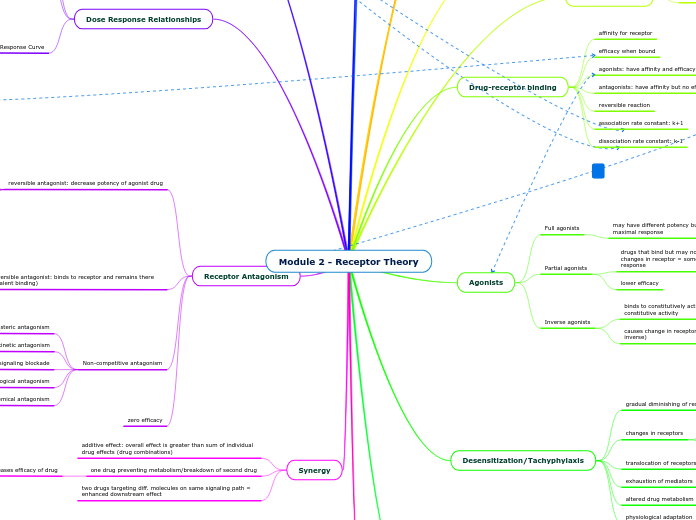Module 2 - Receptor Theory
drug target = receptor
drug targets
membrane receptors
ion channels
carriers/transporter molecules
enzymes
"Drug won't work unless it is bound"
Spare Receptors
unbound receptors/receptor reserve
large number spare receptors = modest amounts of ligands have greater change of inducing maximal response; easier for ligand to find receptor
Drug-receptor binding
affinity for receptor
efficacy when bound
agonists: have affinity and efficacy
antagonists: have affinity but no efficacy (no effect)
blocks agonist ligands from binding same receptor
reversible reaction
association rate constant: k+1
dissociation rate constant: k-1
Agonists
Full agonists
may have different potency but can achieve maximal efficacy, maximal response
Partial agonists
drugs that bind but may not cause optimal conformational changes in receptor = some response but not maximum response
lower efficacy
Inverse agonists
binds to constitutively active receptor = reduction in that constitutive activity
some receptors have low level of constitutive activity regardless of agonist being bound
causes change in receptor signal (a reduction though, hence inverse)
negative efficacy
Desensitization/Tachyphylaxis
gradual diminishing of response to drug - tolerance
changes in receptors
altered conformation
uncoupling of associated signaling molecules
translocation of receptors
which are destroyed
exhaustion of mediators
altered drug metabolism
physiological adaptation
systems in body try and compensate for imbalance
Quantal response
dose at which patient responds; all or nothing
ED50 is dose that produces desired effect in 50% of treated population
population response curve uses quantal data as a frequency distribution curve to allow for evaluation of drug efficacy in total population
Drug-receptor interaction
Equilibrium dissociation constant (KD): concentration of drug required to occupy 50% of receptors
KD units of concentration: mol/L (M)
can be graphed linear or logarithmic
KD = k-1/k+1 [A][R]/[AR]
shoes ratio of occupied receptors to unbound receptor and drug
drug w/ high affinity for receptor
lower dose required to achieve 50% receptor binding
lower KD
drug w/ low affinity for receptor
higher dose required to achieve 50% receptor binding
higher KD
Law of mass action
k+1[A][R] = k-1[AR]
no more drug added and rxn eventually reaches equilibrium where association rate = dissociation rate and conc. of reactants and products doesn't change
rate of rxn proportional to the product of concentration of reactants
Main topic
Percentage of drug-bound receptors
PA = [AR]/[Rtot] = [A]/KD+[A]
Subtopic
concentration of receptors occupied/total receptor concentration
can't determine number of receptors, but we do know KD for drugs
calculates effects of antagonist or agonist receptor binding
Dose Response Relationships
%age drug bound o receptor may not be equivalent to %age of real tissue response
KD replaced by ED50 (50% effective dose - dose required to illicit 50% maximal biological response) or EC50 (50% effective concentration)
ED50 & EC50 describe potency of drug
Dose Response Curve
time dose is administered and the response achieved
log scale used because effects usually occur w/in narrow concentration range
ED50 is measure of potency (power of drug)
ED25 (amount of drug to get 25% response)
ED90 (amount of drug to get 90% response)
potency indicates amount of drug required to achieve specific LEVEL of response
Efficacy: maximal effect of drug at saturating concentrations
agonist can stimulate a signal response from a receptor (intrinsic activity)
Receptor Antagonism
reversible antagonist: decrease potency of agonist drug
competes for binding sites and dilutes agonist
if you add more agonist you can recover same receptor occupation
administering reversible competitive antagonist in presence of agonist drug shifts binding curve right (more agonist needed to achieve same receptor occupancy)
agonist drug in presence of antagonist shifts dose response curve right = increase in effective ED50 of agonist drug)
most common antagonists
irreversible antagonist: binds to receptor and remains there (covalent binding)
reduces potency of agonist drug
reduces total number of receptors available for agonist - reduces maximal response that agonist drug can provoke (efficacy)
seen in case of toxins
Non-competitive antagonism
allosteric antagonism
pharmacokinetic antagonism
signaling blockade
physiological antagonism
chemical antagonism
zero efficacy
Synergy
additive effect: overall effect is greater than sum of individual drug effects (drug combinations)
one drug preventing metabolism/breakdown of second drug
increases efficacy of drug
two drugs targeting diff. molecules on same signaling path = enhanced downstream effect
Therapeutic Index
limiting dose for drug is point that adverse rxns (toxicity) become too great to support its therapeutic usage
TI: LD50/ED50
Drug is considered safe if therapeutic index is high
Drug is unsafe is therapeutic index is low
LD = lethal dose; ED = effective dose
we don't want overlap between therapeutic and toxic doses of drug; greater separation = safer
Certain Safety Factor (CSF) = LD1/ED99
CSF>1 = dose effective in 99% of population is lower than dose that is toxic in 1% of population
CSF<1 = therapeutic dose may be toxic in more than 1% of population
